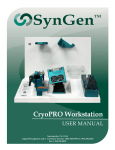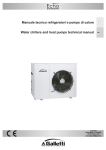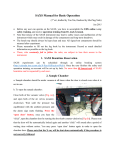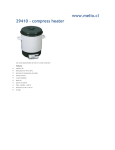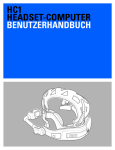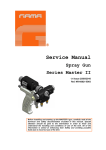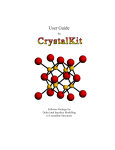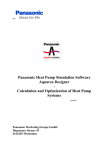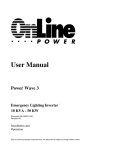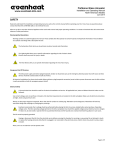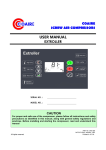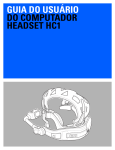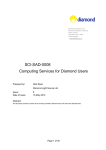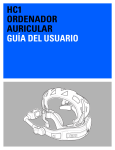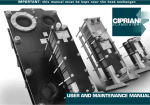Download User`s manual
Transcript
HC1b_UsersManual-R02.docx January 2010 HC1b Humidity Control Device User’s manual EMBL Grenoble Outstation J. Sánchez-Weatherby, J. Huet, S. Russi http://www.embl.fr/research/unit/cipriani/index.html * Current address Daimond Ligth Source, UK 1/15 HC1b_UsersManual-R02.docx January 2010 Before you start It is important that a number of points are considered before using the HC1b. • Crystals need to be brought in their plates to the synchrotron or crystallised onsite (a good stock of crystals is necessary) • Crystals that have been cryo-cooled already are not suitable for these experiments • The crystallisation condition cannot include high amounts compounds • Due to the experiments are carried out at room temperature crystals need to be stable between 20 and 25 °C • Extremely delicate crystals (photosensitive, O2 sensitive, radiation sensitive ...) may have problems • Meshed loops must be used to mount the crystals because they allow removing the excess of mother liquor that surrounds the crystals without damaging them • Exposure time and flux need to be minimised to prevent radiation damage • Crystals need to have enough scattering power to be able to index the image/s • The outcome of the experiment is totally empirical and dependant on the intrinsic nature of the individual crystals. These general guidelines are given as a tool to help the experiment but they do not guaranty success EMBL Grenoble Outstation J. Sánchez-Weatherby, J. Huet, S. Russi http://www.embl.fr/research/unit/cipriani/index.html * Current address Daimond Ligth Source, UK of volatile 2/15 HC1b_UsersManual-R02.docx January 2010 1. The HC1b 1.1. The casing The HC1b is mounted on wheels so it can be easily transported between beamlines. You can pull and steer by using the front handle. There are brakes on both front wheels that are operated with your feet. Brake off Brake on HC1b Handle There are two serial I/O connections, two air inlet connections, an Ethernet connection and a warning ligth at the back of the device. There are two air flow meters, an emergency stop button and on/off button at the front. Front View of HC1b Emergency Stop & ON/OFF Switch Back View of HC1b EMBL Grenoble Outstation J. Sánchez-Weatherby, J. Huet, S. Russi http://www.embl.fr/research/unit/cipriani/index.html * Current address Daimond Ligth Source, UK 3/15 HC1b_UsersManual-R02.docx January 2010 The casing device can be opened by unscrewing two central allen screws at the top of the device. Once they are unscrewed the side panels can be lifted by hand. For safety reasons the two covers and the two top screws should always be mounted when the device is running. Do not unscrew the four screws at the sides. Removal of the cover 1.2. Internal components DG4 DewPoint Controller WAGO Controll er External Air-Flow Meter Peristaltic Pumps Internal Air-Flow Meter Hot Water Bottle 5 l Water Reservoir EMBL Grenoble Outstation J. Sánchez-Weatherby, J. Huet, S. Russi http://www.embl.fr/research/unit/cipriani/index.html * Current address Daimond Ligth Source, UK 4/15 HC1b_UsersManual-R02.docx January 2010 The 5 l water reservoir and the hot water bottle are filled with destilled water and the minumun and maximun levels are indicated. If any of them need refilling and you’re unsure of how to proceed contact a member of the Diffraction Instrumentation Team at the EMBL for assistance. 2. Installation 2.1. Connections Air supply Connect the 6 mm tubing attached to the device to the manual valve connected to the air or nitrogen supply in the beamline (blue or yellow tubing respectively). Once it’s connected you can open the valve. The air connectors lock by simple pressure. Make sure they are tight before you open the valve. To disconnect them you need to push the blue ring at the same time you pull the tubing apart. 6mm tubing & Connecting Disconnecting connector I/O serial port There is an I/O serial port at the back of the humidifier find the one attached to the back of the Windows PC in the hutch. Plug the I/O serial cable to both the device and the computer respecting male/female compatibility. EMBL Grenoble Outstation J. Sánchez-Weatherby, J. Huet, S. Russi http://www.embl.fr/research/unit/cipriani/index.html * Current address Daimond Ligth Source, UK 5/15 HC1b_UsersManual-R02.docx January 2010 Power supply Connect the power plug at the back into a standard wall socket. State light Serial connector Power supply connector Connections at the back of the HC1b All you need plugged into the HC1b The humidifier nozzle head Mounting In order to mount the humidifier Nozzle you first need to remove the cryo-stream. Before remove the cryo-strem unscrews the annealer and removes it gently off the nozzle, then unscrew the two allen screws that hold the nozzle in place and once they are loose gently remove the cryo-stream. There is a special holder at the back of the beamline where you can place it. The nozzle can be left in this place indefinitely whit the cryo-stream still in operation. Alignement Adjust manually the vertical height (with the screw at the top of the holder). If needed readjust the horizontal and vertical position of the nozzle to ensure a centred crystal is fully covered by the air flow. Once the nozzle is in place, mount a loop, centre it and then attach the alignment tool to the nozzle. If required readjust the position of the support to ensure the loop is in the centre of the air flow. EMBL Grenoble Outstation J. Sánchez-Weatherby, J. Huet, S. Russi http://www.embl.fr/research/unit/cipriani/index.html * Current address Daimond Ligth Source, UK 6/15 HC1b_UsersManual-R02.docx January 2010 Cryo support without the cryo-stream and height adjusted to the HC1b nozzle Nozzle head into the HC1b support Nozzle mounted onto the cryo support EMBL Grenoble Outstation J. Sánchez-Weatherby, J. Huet, S. Russi http://www.embl.fr/research/unit/cipriani/index.html * Current address Daimond Ligth Source, UK 7/15 HC1b_UsersManual-R02.docx January 2010 2.2. Checking that everything is working OK Warning light Switch on the machine with the on/off button placed at the front side (green light in button become on) and check that the state light, on the back side, is green and blinks. Wait approximately 15-20 minutes for the stabilization of the device and check if the state light became fixed and green. If the light turns yellow or red you must contact a member of the Diffraction Instrumentation Team at the EMBL for assistance. Air flow The external protective air flow should be at around 10 l/min and the internal air flow at about 5 l/min. Check the flow meters at the front of the device to ensure the flow is correct. The correct flow should produce an even rotation of the fan (too fast will become unstable and too slow will not move fast enough). If the two air flow are zero after a rotation of adjustment button, check air pressure connection (§2.1) or contact a member of the Diffraction Instrumentation Team at the EMBL for assistance. External Air-Flow 10 l/min Internal Air-Flow 5 l/min Control of the internal and external air flow EMBL Grenoble Outstation J. Sánchez-Weatherby, J. Huet, S. Russi http://www.embl.fr/research/unit/cipriani/index.html * Current address Daimond Ligth Source, UK 8/15 HC1b_UsersManual-R02.docx January 2010 3. Software To start the program double click in the HC1b icon placed at the Windows PC desktop. 3.1. The main window Image of the drop, including image processing overlays Humidity and temperature controlers, and script execution Time plot graph of humidity, drop size and/or temperature EMBL Grenoble Outstation J. Sánchez-Weatherby, J. Huet, S. Russi http://www.embl.fr/research/unit/cipriani/index.html * Current address Daimond Ligth Source, UK 9/15 HC1b_UsersManual-R02.docx January 2010 3.2. Selecting the RH percentage Use the HUMIDITY button, on the main window, to enter the RH value required. 3.3. Running a script To run a script click on the main window RUN button, select the script that you’d like to execute and enter the parameters required (leaving a space between each one). For detailed information about the software see the HC1x Software Manual. EMBL Grenoble Outstation J. Sánchez-Weatherby, J. Huet, S. Russi http://www.embl.fr/research/unit/cipriani/index.html * Current address Daimond Ligth Source, UK 10/15 HC1b_UsersManual-R02.docx January 2010 4. Getting started 4.1. Determination of the RH starting point Check that the “Drop Size Tracking” option is selected in the main window. Center the loop perpendicular to the plane of the image and put a drop of the crystallization condition on it. Define the drop size selecting with the left button of the mouse the ROI (region of interest). Follow the drop size behavior. If the drop increases the size, decreases the RH value and if the drop decreases the size, increase the RH value. Repeat the procedure, with a fresh drop, until you reach a constant drop size. Drop size Drop size tracking EMBL Grenoble Outstation J. Sánchez-Weatherby, J. Huet, S. Russi http://www.embl.fr/research/unit/cipriani/index.html * Current address Daimond Ligth Source, UK 11/15 HC1b_UsersManual-R02.docx January 2010 4.2. Dehydration standard protocol Set the RH value at the starting point determined as described before. Mount and center a crystal removing the excess of mother liquor that surrounds it with a paper wick. Take a diffraction image to characterize the initial state (space group, unit cell, mosaicity, etc). Decrease the RH value in steps of 1%, letting the crystal reach the equilibrium (5 minutes approx.) and taking a diffraction image to compare with the previous ones. In case that an improvement is observed, further optimization will be needed. EMBL Grenoble Outstation J. Sánchez-Weatherby, J. Huet, S. Russi http://www.embl.fr/research/unit/cipriani/index.html * Current address Daimond Ligth Source, UK 12/15 HC1b_UsersManual-R02.docx January 2010 Appendix: FAQ How does the machine work? The machine produces an airstream around the sample at controlled relative humidity (RH) that can be used to change the hydration state of macromolecular crystals. This airstream is generated by using DewPoint to remove water from a hot and saturated airstream so that it will be at the correct RH when it reaches the crystal. In practice what you will see at the beamline is a device next to the diffractometer and a nozzle that looks like a standard cryo-stream. Your crystals can be directly mounted by hand, as you would normally if you where cryo-cooling directly on the beamline and from that point onwards nothing much changes from a standard data collection. Why use dehydration? Dehydration is a known factor to affect crystal lattice. The changes it produces in the packing can, in some cases, lead to improved diffraction properties. Unit cell contraction, decreased mosaicity, space group changes and even improved diffraction limit are among the documented effects. Why use a device and not chemical methods? The advantage of using a device to control dehydration relies on the fact that we can couple it with data collection and we can precisely control the speed at which the experiment happens. In this way you have a direct measurement of the effect dehydration is having on your diffraction with no added treatment, like cryoprotection, prior to data collection. Why use this device and not others? Currently there are other options to carry out this sort of experiments (Acta Cryst. D61, 1173-1180 & Applied Cryst. 33(5), 1223-1230). Despite being perfectly suitable to perform dehydration they are not very user-friendly and are not available for use at a synchrotron beamline. The new HC1b device is easy to mount on a standard EMBL Grenoble Outstation J. Sánchez-Weatherby, J. Huet, S. Russi http://www.embl.fr/research/unit/cipriani/index.html * Current address Daimond Ligth Source, UK 13/15 HC1b_UsersManual-R02.docx January 2010 beamline without disturbing any of the other equipment. It is easy to use and to monitor progress to anyone used to normal operation within a standard beamline. Why perform this experiment in a beamline rather than at my home source? In principle your homes source is perfectly good for this sort of experiments, will definitely pose less threat to your crystals in terms of radiation damage and you will not "waste" a day of good beamtime. Despite this, many "bad" diffracting crystals only give any hint of diffraction once they are tested on a synchrotron and thus will have not opportunity at a home lab. Furthermore, the time required for collecting a single frame in house (5-30 minutess) gives very little opportunity of recording changes that happen within a shorter time span. At a beamline the typical exposure time 0.1-2 seconds permits accurately characterising the most subtle change. Lastly, despite requiring a long time these experiments are often performed as part of a broader approach to obtain suitable data. In many important cases a number of synchrotron shifts is required to test hundreds of crystals that have been harvested over weeks or months of careful work in order to obtain that elusive dataset. If this beamtime is used responsibly it can only help in achieving that final goal. What do I need to look for in my crystals? This is a difficult question as no thorough work has ever been undertaken. There are several pointers that may hint about the likeliness of your crystals changing. In principle the solvent content may be a good indication that there is room for improvement. The more solvent in your molecules the more solvent can be excluded and the more space there is for the molecules to move. Despite this, keep in mind that if the crystals harbour a membrane protein with some form of detergent or membrane between the different protein molecules there is not as much removable solvent and thus may not permit the required rearrangement. The second thing to look for is a protein capable of crystallising in a number of alternative spacegroups and/or unit cells (more than 1). Interesting also, are those crystals capable of changing packing upon the addition of substrate, additives, cryos ... or that change with different time of harvesting, soaking or cryo-protection. All this sort of changes is indicative of the possibility of movement within the crystal and thus potentially very useful. Symmetry may also be important. In order to improve the internal order of the crystal local rearrangements are needed to realign the molecules or to stabilise flexible EMBL Grenoble Outstation J. Sánchez-Weatherby, J. Huet, S. Russi http://www.embl.fr/research/unit/cipriani/index.html * Current address Daimond Ligth Source, UK 14/15 HC1b_UsersManual-R02.docx January 2010 areas of the individual proteins. If the arrangement of the molecules is such that they establish a great number of equivalent crystal contacts there may be very little hope for such a high number of contacts to be broken and reformed differently. On the contrary, if the symmetry of the crystal is such that a with small compression or rearrangement new symmetry relations can be created a greater number of previously unrelated molecules can now co-contribute to the overall scattering thus increasing the diffraction power/order of the crystal. Furthermore, a similar effect may be triggered by dehydration if the asymmetric unit is constituted by a number of non symmetric monomers. What do I do after dehydrating? Dehydration may actually be an alternative way of cryo-protection. Dehydration will exclude water while increasing the concentration of the buffer within the solvent channels and can thus prevent ice formation. Furthermore, much of the mechanical stress crystals undergo upon flash cooling can be minimised by having contracted the lattice to a minimum prior to cryo-cooling. What if I cannot cryo-cool my crystals after dehydration? If all attempts to cryo-cool the crystals fail to yield a suitable dataset an alternative option is to collect at room temperature. Despite the device being stable enough to permit collecting a full dataset it will have to be collected with great caution. Firstly radiation damage is a mayor worry and thus the data collection strategy has to be meticulously optimised. It may even be necessary to collect data from several crystals in order to get a full dataset. Secondly, as crystals are not cooled they may move complicating data processing. EMBL Grenoble Outstation J. Sánchez-Weatherby, J. Huet, S. Russi http://www.embl.fr/research/unit/cipriani/index.html * Current address Daimond Ligth Source, UK 15/15















